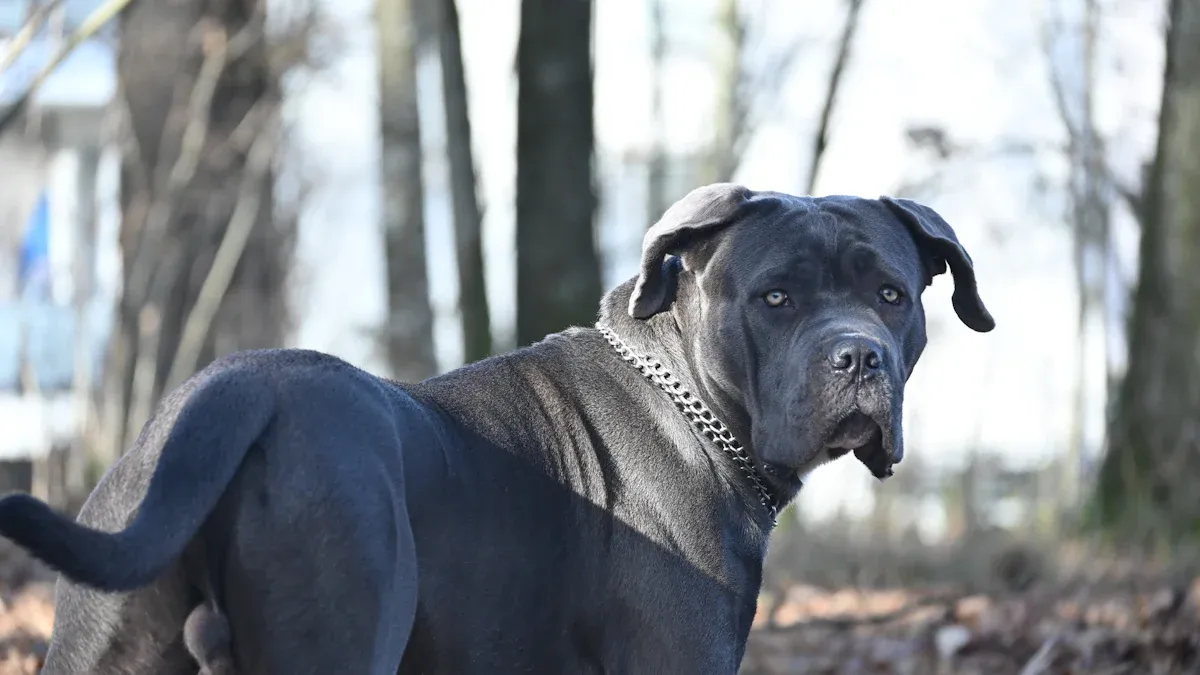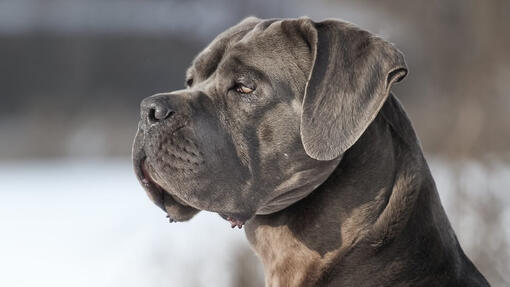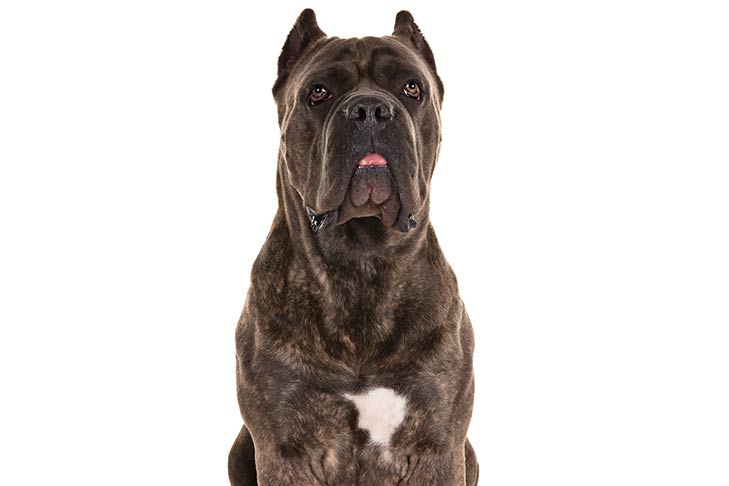Cane Corsos—with their muscular, imposing frames, deep chests, and calm, protective eyes—are often mistaken for “high-energy” dogs, thanks to their history as guard dogs and hunters. But this powerful breed defies simple energy labels: they’re not hyperactive like Border Collies, nor are they couch potatoes like Basset Hounds. Instead, Cane Corsos have moderate, purpose-driven energy—rooted in their heritage as working dogs that needed to stay alert, patrol territories, and act quickly when threats arose.
For Cane Corso owners, the confusion around their energy level often leads to mismanaged exercise: too little activity, and they become bored, anxious, or destructive; too much unstructured play, and they strain their joints or develop behavioral issues. This is where non-electric treadmills for dogs (dog-powered, self-paced machines) emerge as a perfect solution. Unlike electric treadmills that force speed or outdoor runs that risk overexertion, non-electric models let Cane Corsos move at their own pace, turning exercise into a controlled, purposeful activity that aligns with their unique energy needs. Let’s clear up the “high energy” myth, break down Cane Corsos’ true activity requirements, and explain how a non-electric dog runner machine can help you keep your Cane Corso healthy, balanced, and happy.
Key Takeaways
-
Cane Corsos need around 90 minutes of exercise each day to be happy and healthy.
-
They also need mental challenges. Training and puzzle games can stop boredom and bad behavior.
-
Change exercise plans as your Cane Corso gets older. Focus on gentler activities to keep their joints safe.
-
Non-electric treadmills are a safe way for Cane Corsos to exercise, no matter the weather.
-
Structured play is very important. Just casual walks do not give Cane Corsos the challenges they need.
The Truth About Cane Corso Energy: Moderate, Not “High”—But Purpose-Driven

To answer “Is a Cane Corso a high energy dog?” we first need to redefine “energy” for this breed. Their energy isn’t about constant movement—it’s about focus, stamina, and a need to feel useful. Here’s what makes their energy unique:
They Have “Working Energy,” Not “Play Energy”
Cane Corsos have what experts call "working energy." This means they do well with tasks that use their bodies and minds. Unlike some high-energy dogs that jump around for fun, Cane Corsos need planned activities. They were bred to be war dogs, herders, and protectors. This history means they need a lot of physical and mental exercise.
To keep your Cane Corso happy, aim for about 90 minutes of exercise each day. This is much more than the average dog, which usually needs about 30 minutes. If they don’t get enough exercise, you might see bad behaviors like boredom, hyperactivity, or even destruction. Here are some activities you can try:
-
Daily walks
-
Fun play sessions
-
Training exercises that challenge them
They Tire Mentally Faster Than Physically
You might be surprised to know that Cane Corsos often get tired mentally faster than physically. While they can run and play for a long time, their brains need just as much, if not more, exercise. Doing training or puzzle games can be as good as a long run. This mental workout helps stop boredom and keeps them well-behaved.
Think about adding activities that challenge their minds, like:
-
Obedience training
-
Agility courses
-
Scent work games
These activities give them exercise and meet their need for mental challenges.
Their Energy Shifts With Age (And Needs Adjustment)
-
Puppies (6–12 months): Have more playful energy, but still need controlled movement—their growing joints (Cane Corsos weigh 80–120 lbs as adults) can’t handle rough play or long runs. Short, frequent sessions (15–20 minutes, 2–3 times a day) are best.
-
Adults (1–7 years): Settle into moderate, steady energy—they need daily structured activity to stay alert and prevent laziness (which leads to obesity).
-
Seniors (8+ years): Energy decreases, but they still need gentle movement to maintain joint health and mental sharpness—short walks or slow trots are ideal.
This isn’t “high energy”—it’s energy that demands intention. A Cane Corso with unmet purpose-driven energy isn’t “hyper”; they’re frustrated.
Why Traditional Exercise Fails Cane Corsos (And Fuels the “High Energy” Myth)

Many owners misinterpret Cane Corsos’ calm demeanor as “low energy” or their occasional bursts of action as “high energy,” leading to exercise routines that miss the mark:
“Casual Walks” Are Too Low-Stimulation (And Boring)
If you think a simple walk is enough for your Cane Corso, you are wrong! These dogs need mental and physical challenges. Simple walks do not give them the stimulation they require. Here’s why:
-
Simple walks do not engage their minds.
-
They need activities that challenge them to stay happy and healthy.
Without enough stimulation, your Cane Corso may get bored and restless. This boredom can cause bad behaviors, making you think they have too much energy when they just need more fun activities.
Unstructured Outdoor Play Risks Injury (And Bad Habits)
Letting your Cane Corso play outside freely might seem good, but it can be dangerous. Unstructured play can cause many problems:
-
Long exposure to extreme weather can lead to heatstroke or hypothermia.
-
There is a higher risk of parasites like ticks and fleas.
-
Injuries can happen from fights with other animals or accidents.
-
Not socializing can lead to behavior problems.
Instead of letting them run around, try structured play that keeps them safe and engaged.
“Too Little Activity” Leads to Behavioral Issues (Mistaken for “High Energy”)
When your Cane Corso does not get enough exercise, it can cause serious behavior problems. You might see:
-
Ongoing stress, which can lead to aggression or destructive behavior.
-
Higher chances of getting sick due to stress.
-
Feeling lost, leading to bad behaviors.
If you notice these signs, it’s important to change their exercise routine. Remember, a well-exercised Cane Corso is a happy and well-behaved dog. By understanding their needs, you can help them thrive and prove they are not a high-energy breed.
How Non-Electric Treadmills for Dogs Meet Cane Corsos’ Unique Energy Needs

Non-electric treadmills for dogs are designed to work with Cane Corsos’ moderate, purpose-driven energy—not against it. They solve the flaws of traditional exercise by providing controlled, mental-physical engagement that aligns with their working heritage. Here’s how:
Low-Impact Movement Protects Joints (Critical for Large Breeds)
Cane Corsos are big dogs, so their joints need special care. Non-electric treadmills let them move without too much impact. This is important for keeping their joints safe. This kind of exercise helps their bodies while giving them the workout they need. Here are some health benefits of using a treadmill:
|
Health Benefit |
Description |
|---|---|
|
Cardiovascular fitness |
Makes the heart stronger, improves blood flow, and helps lungs work better. |
|
Joint and muscle development |
Works muscles evenly, building legs and core muscles. |
|
Weight management |
Helps burn calories in a controlled way, lowering obesity risks. |
|
Increased stamina and endurance |
Lets dogs run as much as they want, building great endurance over time. |
|
Injury prevention |
Low-impact exercise is easy on joints, perfect for dogs needing regular exercise without strain. |
Self-Paced Exercise Aligns With Their “Working Rhythm”
Cane Corsos don’t like being forced to move faster than they want—they prefer to set their own pace, just like they would when patrolling a territory. A non-electric treadmill lets them walk, trot, or slow down as needed: if they want to pause and catch their breath, they simply stop (the belt stops with them). This control turns exercise into a “choice,” not a chore—making them more engaged and less resistant. For example, a Cane Corso might start with a slow walk to “survey” the room, then pick up speed into a trot—mimicking their natural patrol behavior.
Adds Mental Stimulation (Turns Exercise Into “Work”)
Treadmill workouts are not just for physical fitness; they also help their minds. As your Cane Corso walks or runs, you can add commands or tricks. This makes exercise a fun training time, keeping their minds active. Keeping their brains busy helps reduce bad behavior, leading to better overall health. Here are some ways treadmill exercise can boost mental stimulation:
-
Treadmill exercise makes a Cane Corso think more while moving.
-
You can teach commands or tricks during treadmill time, boosting mental activity.
-
A busy mind helps lower the chances of bad behavior, improving their health.
Weather-Proof (Consistent Activity, No Excuses)
Cane Corsos have a short, dense coat that offers little protection from extreme weather: they overheat quickly in temperatures above 80°F/27°C (their heavy bodies trap heat) and get cold in temps below 40°F/4°C. A non-electric treadmill lets you exercise them indoors, in a controlled environment (68–72°F/20–22°C is ideal), so you never have to skip a session due to rain, snow, or heat. Consistent activity prevents boredom-induced behavior issues and keeps their weight in check (obesity is a major risk for Cane Corsos).
Manages Weight Without Overexertion
Keeping a healthy weight is very important for Cane Corsos, especially as they grow older. Non-electric treadmills let you control how hard and how long they work out. This way, you can help them burn calories without pushing them too hard. Regular treadmill exercise can stop obesity and keep your dog in good shape.
Adding treadmill workouts to your Cane Corso's routine can greatly improve their physical and mental health. By giving them a safe place to exercise, you can help your dog thrive.
How to Introduce Your Cane Corso to a Non-Electric Treadmill
Cane Corsos are intelligent and cautious—they’ll approach new equipment with wariness, not excitement. Follow these steps to make the treadmill a positive experience:
Step 1: Let Them “Inspect” the Treadmill (No Pressure)
Set the non-electric treadmill in a room your Cane Corso frequents (e.g., the living room or garage). Turn it off (the belt stays still) and let them sniff it, paw at the belt, and walk around it. Offer high-value treats (like freeze-dried beef or raw meat) while they explore—this builds a “treadmill = good things” association. Cane Corsos are naturally curious, but they need time to trust new objects—don’t rush this step (it may take 1–2 days).
Step 2: Guide Them Onboard With a Purpose (Not Just “Exercise”)
Once they’re comfortable near the treadmill, stand beside it and hold a treat in front of their nose. Gently guide them onto the belt—if they hesitate, stop and try again later. Once they’re on, encourage them to take a few slow steps (the belt will move slightly as they walk). Keep the first session short (5–10 minutes) and focus on commands like “walk” or “wait”—this makes the treadmill feel like a training task, not just movement. End with lots of praise and a treat.
Step 3: Build Routine (Key for Cane Corso Balance)
Cane Corsos thrive on consistency. Schedule treadmill sessions at the same time daily—e.g., 7 AM before work (to “start their patrol”) or 6 PM after dinner (to wind down). Keep sessions to 20–30 minutes for adults, 10–15 minutes for puppies, and 10 minutes for seniors. Pair the treadmill with a small “job” afterward—like letting them “guard” the door while you prepare their food—to reinforce their sense of purpose.
Step 4: Monitor for Signs of Discomfort (Joint and Heat Check)
Always stay with your Cane Corso during treadmill sessions. Watch for:
-
Joint pain: Limping, lagging, or avoiding putting weight on a leg (common in seniors or puppies).
-
Heat stress: Heavy panting, drooling excessively, or slowing down suddenly (even indoors—Cane Corsos generate lots of body heat).
-
Anxiety: Freezing up, trying to jump off the belt, or ignoring treats (a sign they’re overwhelmed).
If you see any of these, stop the session immediately and let them rest. Consult your vet if signs persist—joint issues or anxiety may need additional care.

So, is a Cane Corso a high energy dog? No—but they are a purpose-driven dog with moderate energy that demands intention. Traditional exercise often fails them because it’s either too unstructured (leading to boredom) or too intense (leading to injury). A non-electric treadmill for dogs fixes this by meeting their unique needs: it’s low-impact, self-paced, mentally engaging, and weather-proof—turning exercise into a activity that feels like “work,” not a chore.
For Cane Corso owners, the goal is to harness their breed’s natural instincts, not fight them. A non-electric treadmill lets you do that: it lets your Cane Corso move at their own pace, feel useful, and stay healthy—all while strengthening your bond (they’ll learn to associate the treadmill with your guidance and praise).
At the end of the day, a balanced Cane Corso is a happy Cane Corso: calm, protective, and content in their role as your companion. A non-electric treadmill isn’t just a piece of equipment—it’s a way to honor their working heritage and give them the structured activity they need to thrive. If you’re struggling to manage your Cane Corso’s energy, a non-electric treadmill is an investment in their health—and in the special, loyal relationship you share.










0 Comments